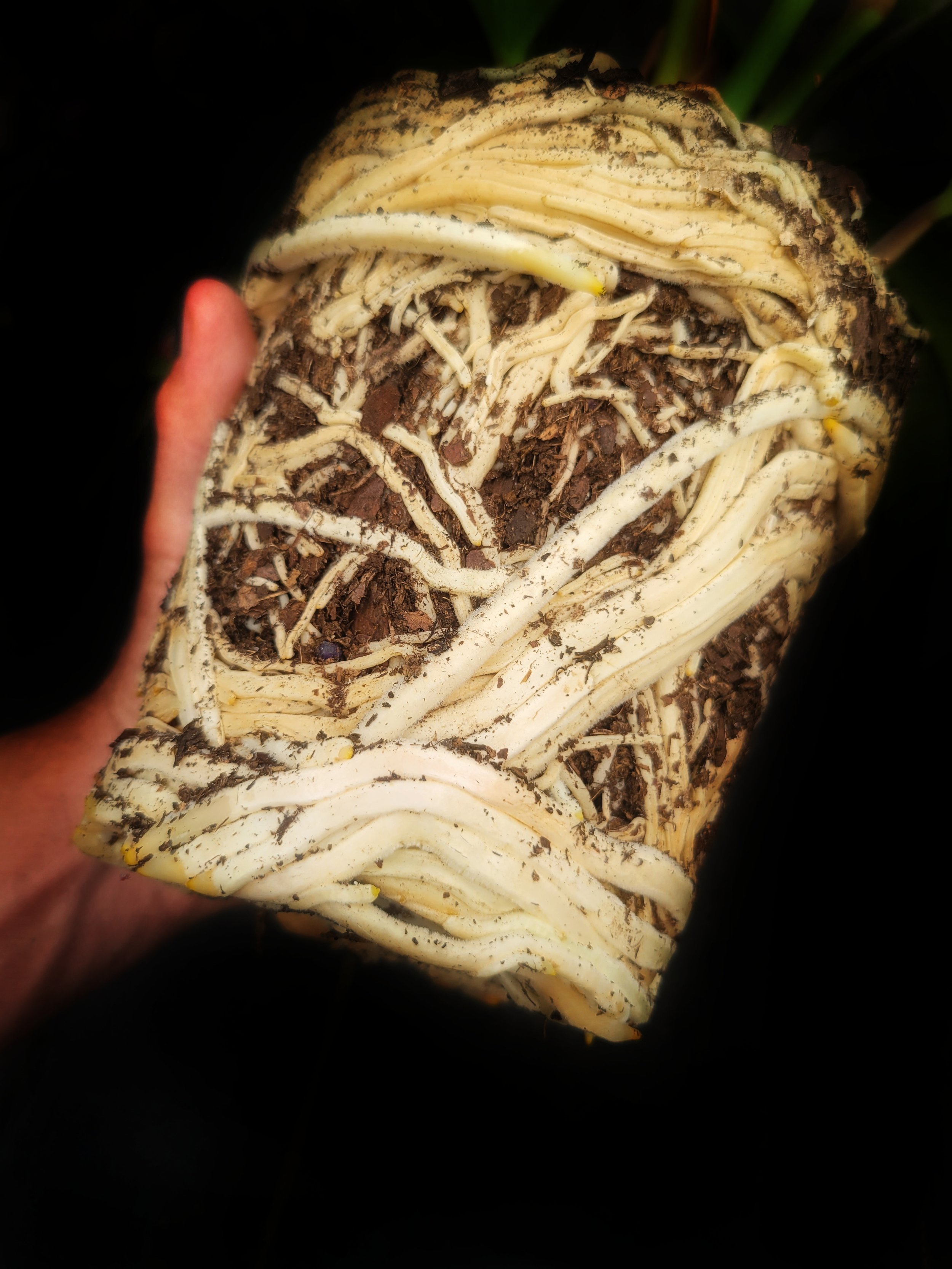AROIDS
ANTHURIUM CHRYSTALLINUM
Philodendron - Monstera - Pothos - Alocasia - Colocasia
The Aroid family contains some of the biggest and most beautiful leaves in the plant world. They come in all sorts of colors, sizes, shapes and patterns. Best of all- many of the favorites (like monstera) have stunning variegation and holes in their leaves. These holes are called fenestrations, coming from the Latin word ‘fenestra’, meaning window. While beautiful in their own right, these windows also serve a purpose- they allow light to reach leaves lower on the plant stems. This adaptation is a clue into the way they grow in the wild, and peering through these windows we can gain an understanding of how to make these plants thrive in the home.
In the Aroid community it is said that the more beautiful the leaf, the uglier the flower and vice versa. It also happens to be the family of the largest inflorescence, belonging to Amorphophallus titanum, the Titan Arum. Titus is a good example; with no leaves at all during flowering, it has one of the most outrageous and strange flowers of all plants. Monstera adansonii, on the other hand, has beautiful fenestrated leaves, and a completely insignificant bland flower. Peace ‘lilies’ are popular because they have a good mix of both beautiful leaves and flowers.
PHILODENDRON BALAOANUM
Aroids are some of the easier plants to grow, hence their huge popularity as houseplants. Pothos, monstera, scindapsus, and philodendron are all extremely hardy vining plants and have some of the prettiest foliage. All of these plants can tolerate very low light compared to other plants, and aren’t too bothered by the lower humidity of houses. As with most tropical plants though, the more humidity you can give them the faster they will grow. They are, after all, understory plants, and the transpiration of the forest canopy provides them with constant moisture in their environments. This means too that they do not require very intense lighting.
EPIPREMNUM ALBO & MOSS POLE
It is for this same reason- their preference on being understory plants- that the fenestration adaptation has become so prominent among the aroids. If you consider that competition for space and light is high among understory plants, especially ones that climb, these ‘windows’ allow the plant to capitalize on light- even for leaves lower on the stem. These windows allow light to penetrate the top ‘tiers’ of leaves, keeping lower leaves in tact and useful. It would do an aroid no good for their new growth to completely block the old.
This is why aroid enthusiasts will grow their plants with a moss pole in the pot. These poles not only allow the plants to climb as they would in nature, but encourages fenestration too. The higher aroids climb, the more likely they are to take on their ‘mature’ or adult-stage leaves. Only climbing branches have a need for windows- vines cascading down don’t have to worry about blocking light. The same pothos you see with small, complete leaves in grocery stores can actually grow adult foliage that is completely different and much larger- not at all resembling the juvenile leaves you’re used to seeing.
We grow most of our aroids in a very chunky, airy potting media consisting of sphagnum moss, perlite, pine bark, charcoal, and a little peat moss. The best way to grow these plants is giving their roots as much air and water as you can- this translates to a potting media that holds water well, but is coarse and allows water to drain and air to get to the roots. A simplified version of this soil recipe is simply 50/50 perlite and peat moss. Perlite helps with drainage, and the peat moss helps hold moisture and lowers the pH as aroids are typically acid loving plants. Always allow the soil to mostly but never completely dry before watering.
ANTHURIUM ROOTS- Note the coarse bark soil, and heavy dense roots
One characteristic that stands out almost universally with the aroid family is that many aroids are toxic or otherwise harmful if ingested. This is because aroids, more often than not, contain toxic compounds (calcium oxalate) that cause nausea and vomiting, among other symptoms. Some species also have something called sclereids- lignified, crystal like structures that resemble tiny shards of glass. Even the ‘edible’ species, such as taro root, must be cooked thoroughly before eating to break these crystals down. Eating raw taro with intact sclereids is likened to swallowing glass, irritating your throat and mouth. Cooking denatures and eliminates these structures. This is also where another popular houseplant- dumbcane- got its name. Aptly named, eat some dumbcane (please don’t) and you’ll be hard pressed to speak for days.
While its not very common for animals to eat them, this is a good reason to be mindful of where you grow your aroids if you have toddlers or animals in the home. Most like pothos just cause nausea and similar symptoms, but some can be more harmful.
Aroids like pothos aren’t very demanding as far as fertilizer goes, but will benefit from a slightly diluted liquid fertilizer every two or so weeks. Use at the strength recommended on the label, and if in doubt- dilute it.
To summarize: most aroids will thrive in bright indirect light, consistent watering and allowing the soil to mostly dry in-between. For the best and fastest growth, allow your aroids to climb, keep the humidity high and fertilize every 2 or so weeks with a dilute liquid fertilizer.




